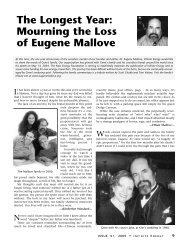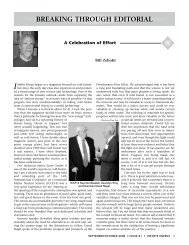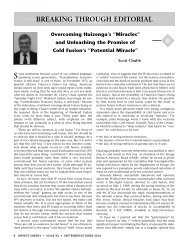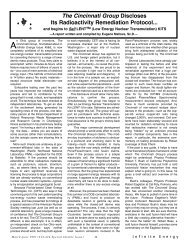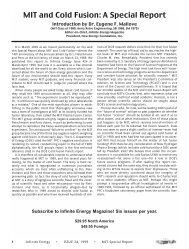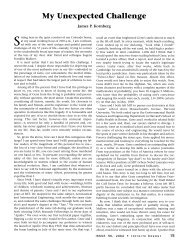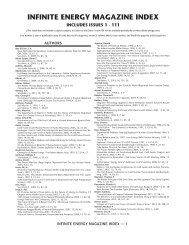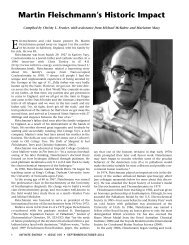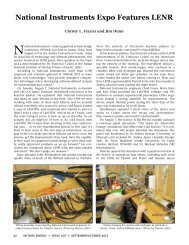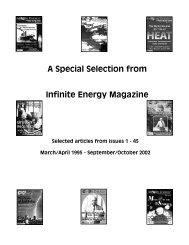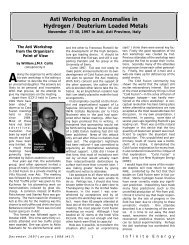Summary of ICCF14 - Infinite Energy Magazine
Summary of ICCF14 - Infinite Energy Magazine
Summary of ICCF14 - Infinite Energy Magazine
Create successful ePaper yourself
Turn your PDF publications into a flip-book with our unique Google optimized e-Paper software.
electro-deposited and codeposited material in palladium and<br />
palladium alloys. He suggests that each location may have<br />
differing rates <strong>of</strong> (or no) excess heat, tritium, and helium production.<br />
Swartz expands on the 3RH in this issue <strong>of</strong> IE.<br />
On Monday, Shaul Lesin (Energetics) also gave a very<br />
important talk titled, “Ultrasonically-Excited Electrolysis<br />
Experiments at Energetic Technologies.” The talk was important<br />
because Lesin discussed experiments and experimental<br />
techniques that have demonstrated a highly successful (80%<br />
success rate) procedure for reproducing the excess heat effect<br />
and at magnitudes that are considerably larger than have<br />
been observed elsewhere. Key results that Lesin discussed<br />
involved modifying surfaces: 1) using short sequences <strong>of</strong><br />
ultrasonically induced cavitation cycles (for cleaning the<br />
electrode surfaces), followed by low current density electrochemical<br />
loading, using Dardik’s superwaves and 2) cleaning<br />
the electrode surfaces by etching them using glow discharge<br />
pulses that are constructed using superwaves, and then<br />
applying electrolytic currents that are also produced using<br />
superwave forms. Superwaves consist <strong>of</strong> highly non-linear<br />
(fractal) modulation.<br />
After preparing the electrodes using ultrasound, as reported<br />
during ICCF13 by Tatiana Zilov on behalf <strong>of</strong> Emanuel Castagna<br />
(www.infinite-energy.com/images/pdfs/chubbiccf13.pdf),<br />
Energetics has found evidence <strong>of</strong> HAD. Lesin mentioned this<br />
fact, and reported information about three additional sets <strong>of</strong><br />
experiments (#56, #64b, and #64a) involving electrode pretreatment<br />
with cavitation. In 64b, they found that the maximum<br />
Coefficient <strong>of</strong> Productivity (COP) Ratio (= Output<br />
Power/Input Power= (1+Excess) Power/Input Power) was<br />
greater than 15 (Percentage Excess Power/Input<br />
Power>1400%). In experiment 64a, they found an even<br />
higher maximal COP value, COP >~25 (Excess/Input<br />
%>2400%). In experiment 56, the ratio was 8<br />
(Excess/Input%>700%). Excess heat in experiment 56 continued<br />
over the longest period <strong>of</strong> time (~300 hours), while<br />
excess heat in the other two experiments, 64b and 64a,<br />
respectively, was produced for periods <strong>of</strong> 17 and 80 hours. As<br />
a result, although the maximum COP that occurred in experiment<br />
56 was only 8, the amount <strong>of</strong> excess energy, 3.1 MJ,<br />
that was produced during this experiment was comparable<br />
to the amount, 3.5 MJ, found in experiment 64b. In the<br />
experiment (64a), where the maximum amount <strong>of</strong> power<br />
was produced, the input power was less than 1 W, and the<br />
output power was greater than 20 W.<br />
The other two Tuesday morning sessions, “Gas and Fast<br />
Loading” and “Honoring Stanislaw Szpak,” were also important.<br />
These session names, as well as “Honoring Yoshiaka<br />
Arata,” are somewhat unusual. The conference organizers<br />
were criticized prior to the event by New <strong>Energy</strong> Times’ Steve<br />
Krivit (www.newenergytimes.com/news/2008/CMNS-LENR-<br />
Update-20080804.htm) for scheduling and titling sessions<br />
that explicitly honored Szpak and Arata. Although it is<br />
unusual to “honor” an individual by using the individual’s<br />
name in the title <strong>of</strong> a particular scientific session, it is worthwhile<br />
noting that the contributions <strong>of</strong> Szpak and Arata have<br />
been extraordinary. On the other hand, the name “Gas and<br />
Fast Loading” is somewhat misleading. All three sessions, in<br />
principle, can be related to a more unifying theme associated<br />
with the potential role <strong>of</strong> smaller (micro- and nano-scale)<br />
structures in triggering the FPE. Micro- and nano-meter scale<br />
effects seem to be common in all <strong>of</strong> the associated experiments<br />
that were presented these three sessions. Further studies<br />
that focus on these kinds <strong>of</strong> structures and experiments<br />
should take place. However, the results presented in these<br />
sessions were sufficiently important that the somewhat<br />
unusual manner that they were introduced does not appear<br />
to have had a negative impact.<br />
Pr<strong>of</strong>essor Jean-Paul Biberian began the “Gas and Fast<br />
Loading” session with an overview <strong>of</strong> gas loading experiments<br />
that emphasized general features <strong>of</strong> the work.<br />
Biberian did not emphasize the importance <strong>of</strong> nanometer<br />
scale crystals in the associated effects. He did mention some<br />
<strong>of</strong> the work that he and Nicholas Armanet have done with<br />
these kinds <strong>of</strong> materials. During ICCF13 and during the<br />
“International Workshop on Anomalies in<br />
Deuterium/Hydrogen Loading in Metals,” that was held last<br />
October in Catania, Sicily, he and Armanet provided a much<br />
more complete summary <strong>of</strong> their work. Pr<strong>of</strong>essor Biberian’s<br />
knowledge and wisdom are important, and it was wonderful<br />
to hear him speak.<br />
Francesco Celani talked about related phenomena involving<br />
nm-scale materials, “Deuteron Electromigration in Thin<br />
Palladium Wires Coated with Nano-Particles: Evidence for<br />
Ultra-Fast Deuterium Loading and Anomalous, Large<br />
Thermal Effects.” He mentioned that they have been working<br />
on a variant <strong>of</strong> the approach involving the nm-meter<br />
scale Pd/ZrO 2 crystals that Arata has developed. This new<br />
procedure has been conducted at the Instituto di Nazionale<br />
di Fisica Nucleare (INFN) in Frascati, Italy.<br />
The particular experiments have involved the detection <strong>of</strong><br />
anomalous thermal effects in long (50-150 cm) and thin (50<br />
µm) Pd wires. The wires, which were coated with a mixture<br />
<strong>of</strong> salts <strong>of</strong> nm-scale materials, were fabricated from a deposition<br />
procedure that involves a thin film coating that forms<br />
from high temperature heating. The associated coating produces<br />
new forms <strong>of</strong> heat. The wires were put in a stainless<br />
steel chamber pressurized with deuterium gas that is similar<br />
to the configuration used by Arata. The chamber includes a<br />
calibration form <strong>of</strong> joule heating that involves a DC current<br />
(J=5000-50000 A/cm 2 ). The combined effect <strong>of</strong> high electric<br />
field and high temperature caused a large deuteron electromigration<br />
in the wires. After D 2 was introduced with a pressure<br />
<strong>of</strong> 5 bar, it was possible to obtain high loading very rapidly<br />
(within 6-12 s) for short periods <strong>of</strong> time, with a steady<br />
state average <strong>of</strong> 0.8 D-atoms per Pd atom, and anomalous<br />
thermal effects when large electro-migration currents were<br />
present. Apparently, the combination <strong>of</strong> using nanometer<br />
scale materials, gas-loading procedures, and wires with currents,<br />
involving high electric fields, and potential forms <strong>of</strong><br />
electro-migration, appeared to be helpful in creating a reproducible<br />
form <strong>of</strong> excess heat.<br />
In the final Tuesday morning session honoring Stanislaw<br />
Szpak, Dr. Frank Gordon and Dr. Pamela Mosier-Boss from<br />
the Naval Space Warfare Center, San Diego (NSWCSD),<br />
Larry Forsley, from JWK, Inc. (Annandale, VA), and Pr<strong>of</strong>essor<br />
Melvin Miles (Dixie State College, formerly, La Verne<br />
College, La Verne, CA, and Naval Air Warfare Center,<br />
Weapons Division, China Lake, CA) provided an overview <strong>of</strong><br />
some <strong>of</strong> the remarkable effects that have come out <strong>of</strong> pioneering<br />
ideas that Stanislaw Szpak has developed. This work<br />
involves an alternative way <strong>of</strong> creating the FPE, in which the<br />
effect is triggered electro-chemically in a way that differs significantly<br />
from what was initially done. In particular, in the<br />
co-depositional procedure suggested by Dr. Szpak, Pd and<br />
deuterium are deposited simultaneously on a substrate. As a<br />
SEPTEMBER/OCTOBER 2008 • ISSUE 81 • INFINITE ENERGY 5



